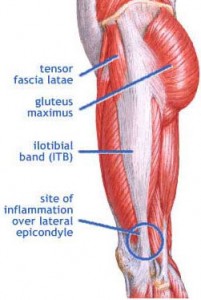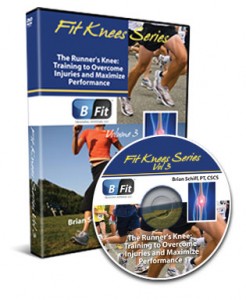Brian Schiff’s Blog
Injury Prevention, Sports Rehab & Performance Training Expert
Eliminating tightness in the TFL can reduce tension in the IT band as well as reduce knee pain associated with Runner’s knee or patellofemoral pain syndrome. Foam rolling prior to stretching is a good idea, but I think this stretch is a good one for all runners to add to their toolbox whether it be prior to or after a run. Check out the stretch from my online PFP column below:
The tensor fascia lata (TFL) is a problematic muscle for many clients. In many cases, it is synergistically dominant over the gluteus medius and often contributes to tightness associated with the IT band. Its actions are primarily hip flexion and abduction, and it tends to be tight in many runners and athletes I see. Performing targeted soft tissue mobilization can help resolve myofascial tightness as well as promote better activation and preferential recruitment of the gluteus medius.
Many people argue the effectiveness of foam rolling the IT band itself. While I am not inclined to ignore it altogether, I do believe that foam rolling probably has a far greater impact on the length/tension of the soft tissue beneath and associated with the IT band (e.g. glutes, quads, hamstrings and TFL). The TFL is often full of trigger points.
Below is a video I created for my Functionally Fit column for PFP Magazine. Employing some routine soft tissue mobilization will help reduce hip flexor tightness and help reset the neuromuscular system and set the stage for enhancing preferential gluteus medius activation during training exercises.
So, a very common issue I see in runners is iliotibial band (ITB) syndrome. In a nutshell, it involves excessive rubbing or friction of the ITB along the greater trochanter or lateral femoral epicondyle. It is more common along the lower leg just above the knee and typically worsens with increasing mileage or stairs.

The ITB is essential for stabilizing the knee during running. Several factors may contribute to increased risk for this problem:
- Muscle imbalances (weak gluteus medius and deep hip external rotators)
- Uneven leg length
- High and low arches
- Increased pronation leading to excessive tibial rotation = friction of the band
- Improper training progression
- Faulty footwear
- Poor running mechanics
- Limited ankle mobility (specifically dorsiflexion)
- Tightness in the tensor fascia latae (TFL) and glute max
Related information on this topic include a 2010 study published in JOSPT on competitive female runners with ITB syndrome:
Click here to see the abstract of the study
Click here to read an earlier blog post analysis of the above research article
Common signs and symptoms include stinging or nagging lateral knee pain that worsens with continued running. Hills and stairs may further aggravate symptoms. Some runners even note a “locking up” sensation that forces them to stop running altogether. How do I treat this?
Wow! It has been a busy two weeks for me. I have been putting the final touches on a DVD and writing a ton of articles lately. I just returned from speaking for Power Systems at a Total Training Seminar in Missouri in late March. It is always interesting speaking and hearing other presenters.
There is usually no shortage of controversy and conflicting opinions either when it comes to fitness and training. One speaker mentioned that it is perfectly okay to allow the knee to go over the toe with exercise. In fact, this presenter said it was desirable to maximize training. My talk (later on) was on bodyweight training for a healthier knee.
Naturally, I was asked what I thought about the earlier comment. My answer was “it is complicated.” I am not sure that is what the audience wanted me to say. Pressed again later on, I acknowledged that in a repetitve training environment, lunging and squatting with the knee over the toe is not something I recommend. However, if I am retraining a client to be able to descend stairs one foot over the other, the knee does in fact move beyond the toes.
So, there are times in life, where we need to think outside absolutes and adjust our thoughts and training to meet the needs of people at a current time and space so to speak. The real trick is knowing the client, their medical condition, their needs and measuring the response from the body. I hate protocols because no two people are the same, nor do their bodies heal and react the same way.
But, let’s get back to the knee. I talked about assessing the knee and then integrating the “right exercises” to not only correct dysfunction but also to improve fitness and performance. If you think body weight training is useless or for sissies, you may want to think again particularly if you like to run and have any issues with patellofemoral pain (most women do have PF pain or early arthritis).
Consider the research from the Journal of Orthopaedic and Sports Physical Therapy in 2003 where Powers et al. determined that PF joint forces are significantly greater with external loading versus bodyweight only in flexion angles begining at 45 degrees during eccentric loading (lowering down while peaking at 90 degrees) and concentric loading (rising up) at 90 and 75 degrees. What does this mean for you?
Essentially, if you are a runner and suffer from PF pain, you may want to limit deeper range of motion with squatting and/or consider limiting the amount of external loading as well. Even better, you should be doing single leg training keeping this same information in mind. Training is an exact science and most people get it wrong all the time. That is why I am currently working on a Fit Knees DVD series to give trainers and consumers relevant and science based information to direct their training for optimal health and performance.
I just finished volume three in this series and it is ready for official release this Friday. If you are a runner and want a blueprint to train for injury prevention and peak performance, this DVD is for you. Or, if you are a runner who is currently injured or has been plagued by overuse injuries, it is still for you as I have a complete progressive rehab series on the DVD to get you back up and running again.
As a runner myself, I have put these strategies to good use with much success. I thought it was fitting to relase the DVD this week as I prepare to run my 4th half marathon in Charlotte this weekend. Below you will see the product display.
As a blog subscriber or reader, I am offering you $10 off the normal price of $34.95 through midnight Saturday. Simply visit www.fitknees.com and use the copuon code BFITRUN (all caps) at checkout. I am confident you will find it valuable as it covers training from A-Z with warm-up prep, foam rolling, balance training, strength and power exercises, rehab and stretching. It is 65 minutes of power packed content. Here’s to healthier knees and happy running!


